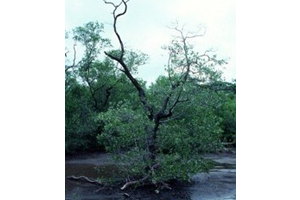Black mangrove plants are surrounded by small, finger-like, woody structures that protrude from their roots (pneumatophores) and specialize in gas-exchange so the submerged roots of the plants can "breathe."
Photo Credit: © Mark W. Skinner, USDA-NRCS PLANTS Database.
Avicennia germinans
Common Name: black mangrove
Plant Functional Group: Evergreen broadleaf
Class > Order > Family: Magnoliopsida > Lamiales > Acanthaceae
What does the species look like?
Black mangrove is an evergreen shrub to tree, growing 30 to 50 feet tall, surrounded by thin, finger-like, upright pneumatophores (oxygen-supplying woody structures) emerging from the roots. Its small, fragrant, white flowers have both male and female parts, and are loosely grouped into showy clusters.
Black mangrove is intolerant of frost or shade. It lives in sandy, silty clay loam, and muck soils flooded with saltwater, and is located in the inland swamps of our southern coast. It is generally found at slightly higher tidal elevations than red mangrove.
Where is the species found?
States & Provinces
FL, LA, MS, PR, TX, VI
Which phenophases should I observe?
Do you see...?
Leaves
Breaking leaf buds More...
How many buds are breaking?
Less than 3 3 to 10 11 to 100 101 to 1,000 1,001 to 10,000 More than 10,000
Young leaves How many young leaves are present?
Less than 3 3 to 10 11 to 100 101 to 1,000 1,001 to 10,000 More than 10,000
Flowers
Flowers or flower buds More...
How many flowers and flower buds are present? For species in which individual flowers are clustered in flower heads, spikes or catkins (inflorescences), simply estimate the number of flower heads, spikes or catkins and not the number of individual flowers.
Less than 3 3 to 10 11 to 100 101 to 1,000 1,001 to 10,000 More than 10,000
Open flowers More...
What percentage of all fresh flowers (buds plus unopened plus open) on the plant are open? For species in which individual flowers are clustered in flower heads, spikes or catkins (inflorescences), estimate the percentage of all individual flowers that are open.
Less than 5% 5-24% 25-49% 50-74% 75-94% 95% or more
Fruits
Fruits Avicennia germinans , the fruit is a fuzzy capsule that changes from yellow-green to tan or brownish and drops from the plant. Fruits typically have a seed already germinated and in a seedling stage before dropping from the plant.More...
How many fruits are present?
Less than 3 3 to 10 11 to 100 101 to 1,000 1,001 to 10,000 More than 10,000
Ripe fruits Avicennia germinans , a fruit is considered ripe when it has turned tan or brownish and readily drops from the plant when touched. Include any fruits whose seed has already germinated and sent out a green root while remaining on the plant.More...
What percentage of all fruits (unripe plus ripe) on the plant are ripe?
Less than 5% 5-24% 25-49% 50-74% 75-94% 95% or more
Recent fruit or seed drop More...
How many mature fruits have dropped seeds or have completely dropped or been removed from the plant since your last visit?
Less than 3 3 to 10 11 to 100 101 to 1,000 1,001 to 10,000 More than 10,000
What do these phenophases look like?
There is currently no photoguide available for this species. If you'd like help us create one, use the guidance document and species template provided here . Then send it via email to education@usanpn.org when it is complete.
